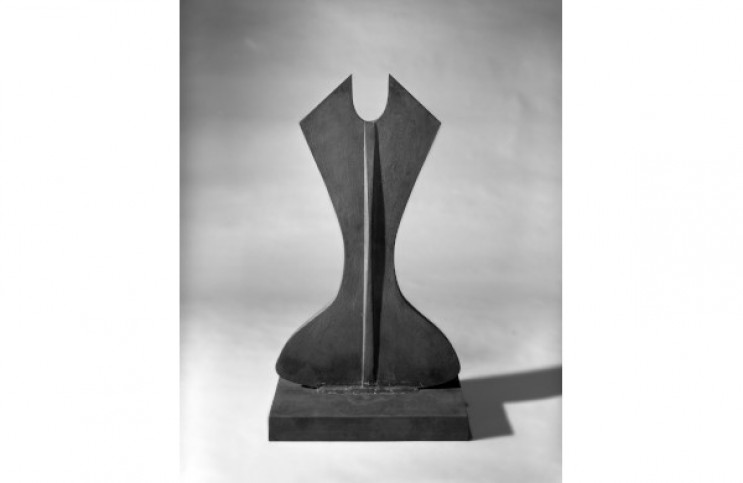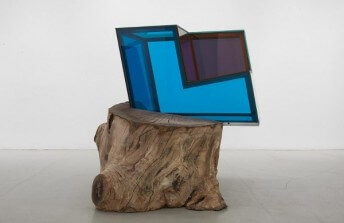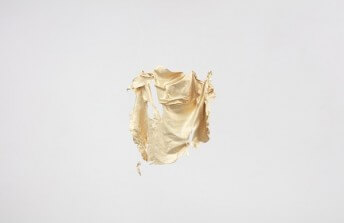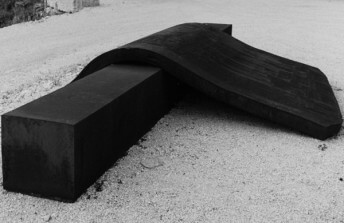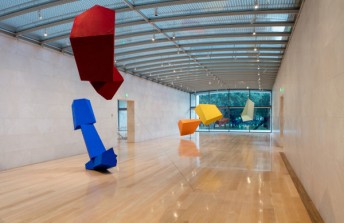The Tall-Standing Sculpture of Beverly Pepper
Apr 8, 2019
Beverly Pepper makes art that subverts the power of the traditional art environment, and returns agency to everyday viewers in the natural and built worlds. Later this year, pepper will turn 97, and she shows no signs of slowing down her work. Yet, public sculpture was not her first career. Before becoming an artist, she had a successful career in advertising, and then experimented with painting. She was nearly 40 when she discovered sculpture. Her inspiration to work three-dimensionally came after seeing ruins being reclaimed by nature in the jungles of Cambodia. She has turned that initial moment of inspiration into a driving force that helped her become a leader in multiple aesthetic tendencies—including Installation Art, Land Art, Site Specific Art, and Public Art—all of which directly engage members of the public in unique and unpredictable ways. Pepper was amongst the first sculptors to make use of COR-TEN steel, a type of building material that contains alloys that give the surface a rust-like appearance, eliminating the need for painting. Her use of this material endows many of her outdoor works with a kinship with the industrial built environment. As the COR-TEN gracefully ages, it evokes the look of train rails, or water towers. Yet, its natural, earthy quality also bring to mind the organic world, making it a perfect complement to wood, stone, and soil. Pepper relishes these visceral qualities when choosing which material to work with. She strives to inject an emotional quality into her work, so that the people who interact with it will connect with it in a unique and personal way. For her, the interaction of a human being with a work of art is a ritualistic experience, during which meaning is established on a fleeting, individualistic level. Just as with her and those ruins back in the jungle, nothing about the meaning of her works is determined ahead of time. Instead, they await each of us, on our own terms and in our own time, so we can discover them where they lie, and explore our own inner relationship to them, using artworks as totems to conjoin us in communion with the larger world.
Habitations and Occupations
Some of the public sculptures Pepper has developed could be described in terms of habitation: meaning they seems perfectly at home in their environment. Many viewers who encounter these works may not even realize they have stumbled upon a work of art. “Sand Dunes” (1985) sits partially concealed in the drifting sand of the beach at New Smyrna, Florida. Made of silver mylar and wood, the 30-meter-long sculpture resembles a crashed UFO, or the twisted wreckage of a building ravaged by hurricane winds. Gracefully, it awaits passersby to catch a glimpse of it glistening in the sun. Elsewhere in Cassino, Italy, the stone earth sculpture “Onphalon” (2001-02) rests in a grassy knoll, like collapsed ruins of an ancient amphitheater. And on the campus of Dartmouth College in New Hampshire, “Thel” (1975-77) graces a bucolic lawn, its white, stainless steel, angular forms protruding out of the earth, covered by dirt and grass like sunken, futuristic ruins. These sculptures are massive, yet nonetheless acquiesce to the natural worlds they inhabit, becoming one with their surroundings as though they were never alien, but were always meant to be where they are.
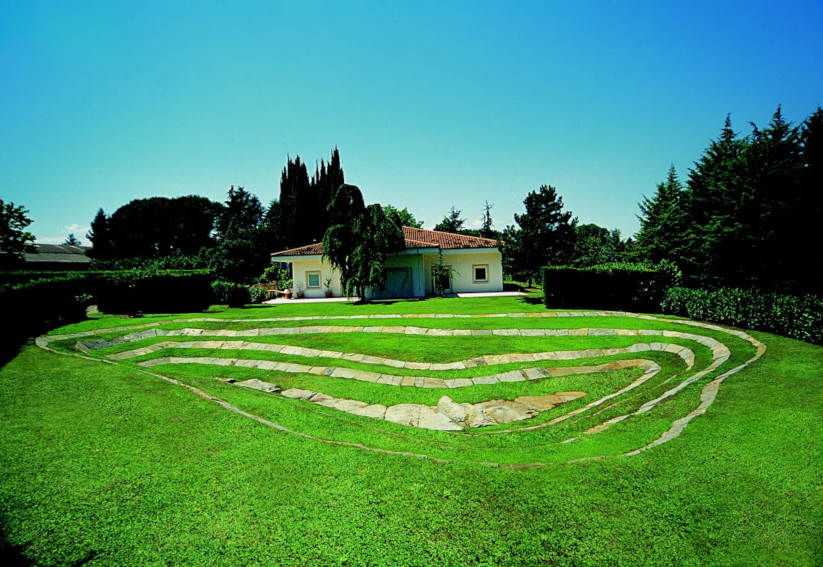
Beverly Pepper - Onphalon, 2001 - 2002. Installation. w25 x h21 x d21 m. From the collection of CAMUSAC Cassino Museum of Contemporary Art.
Other aspects of the public sculpture oeuvre Pepper has created could more accurately be described in terms of occupation. These works claim their territory, establishing themselves as things immovable and timeless. “Manhattan Sentinels” (1993-96), a series of four cast-iron totems rising nearly 12 meters in the air over Federal Plaza in New York City, is flanked by a jungle iconic skyscrapers. Yet, these towering artworks somehow hold their ground, claiming their right to dominate this space, waiting to transmit to us their evolving purpose. Meanwhile, a collection of gargantuan sculptures seize the ancient surroundings of Forte Belvedere in Florence, Italy. “The Todi Columns” (1979) echo the historic architecture, while their Modern forms and materials suggest the futility of newness; thee “San Martino Altars” (1992-93) suggest rusting reverence not for metaphysical deities, but for the gods of industry and manufacturing. Impressive in scale and undeniable in weight, these works rival both the surrounding hills and ancient city for the attention of both our eyes and our hearts.

Beverly Pepper - Untitled (study for Manhattan Sentinels), 1993. Cast iron, steel. 9 h × 7¼ dia in (23 × 18 cm). This maquette was produced as a study for the site-specific installation at the Federal Plaza, New York, 1993-1996.
Land Art
Somewhere between the habitations and occupations are the Land Art works that Pepper creates. Unlike the habitations, they do not so much blend in with their environments as they transform them. Unlike the occupations, they do not assert themselves in a dominant way. “Walls of Memory, for my Grandmother” (1999-2005) in Vilnius, Lithuania, serenely rises from the ground, its concrete walls ridged with the tar covered branches of trees. “Amphisculpture” (1974-75) in Bedminster, New Jersey, deploys the circular logic of an amphitheater to create a walkable public sculpture—part sidewalk and part cosmic shrine. Such works are clearly manufactured human designs, but they convey a feeling of solitude and reverence—a blending of human interference with Utopian ideals.
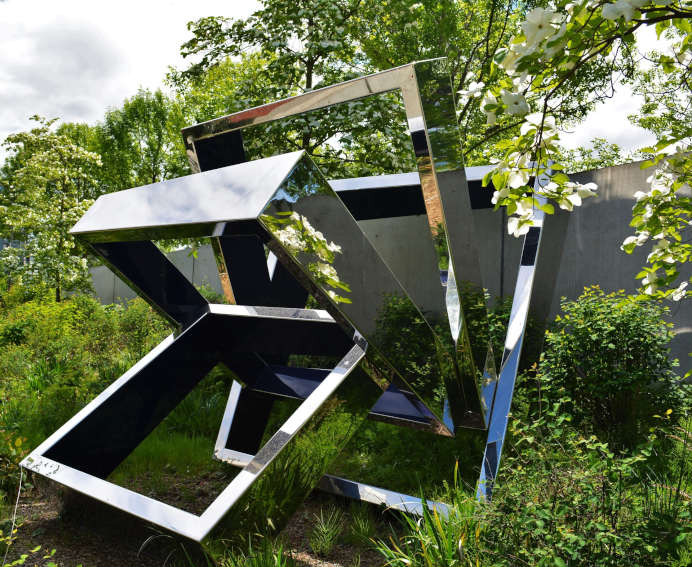
Beverly Pepper - Perre's Ventaglio III, 1967. Stainless steel and enamel sculpture. Installed at Olympic Sculpture Park (Seattle Art Museum), Seattle, Washington. Photo courtesy mcfisher, Seattle, United States.
Among these beloved works is the most recent project Pepper has undertaken. Having lived in Todi, Italy, since the 1950s, she was inspired to help the nearby city of L’Aquila rebuild after it was devastated by an earthquake in 2009. She developed a plan for a monumental reconfiguration of her Amphisculpture concept, called “L'Aquila Amphisculpture.” Part sculpture and part working theater, it is the first ever Land Art installation in L’Aquila. Rising surprisingly out of its natural surroundings, it declares itself as far more than just a work of art, however. It is also a space for performance, a venue for community interaction, and a context for rebuilding of the social fabric. It creates an opportunity for individuals to commune with nature, to interact with each other, and to connect with the larger world—a powerful and mature expression of the ideas that have guided Pepper throughout her career.
Featured image: Beverly Pepper - Janus Rust Altar, 1986. Cast iron. 43 x 22 3/4 in. Brooklyn Museum, Gift of Rosalind E. Krauss, 1991. © Beverly Pepper, courtesy Marlborough Gallery, New York. Photo: Brooklyn Museum.
All images used for illustrative purposes only
By Phillip Barcio
